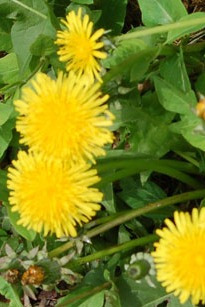Harvest Your Medicine
Finding your medicine in your own backyard is easy and FUN, whether you’re a city dweller, a suburbanite, or country folk. Nearly anywhere I’ve been in the past 18 years, I could look down and around from practically the same spot (including right at this moment- from precisely where I am now standing), and see a fantastic handful of herbs!
For example, from my present position, I see dandelion, sweet violet, clover, plantain, a magnolia tree, a ginkgo tree, and I know right over there sits a burdock patch with plenty of yellow dock. A little further some golden rod and a garden with a big patch of yarrow grow.And it’s only April -in New York City! Right in the middle of this great urban debacle, I have a bevy of herbs that nourish and heal.
Other New York City herbs I’ve found include: willow bark, sassafras, shepherd’s purse, wild mustard, honeysuckle, red raspberry leaf, and even a stray chamomile. These, all found in the larger city parks where the Parks Department claims tax revenue is too scarce to use pesticides. In smaller city patches, as in many areas of the United States, one might encounter more garden-store variety pesticides. So, try for the larger parks near you, and *ask your parks department* about their pesticide policy. Some highly cultivated sections of Central Park, for example, like Shakespeare’s Garden and The Conservatory, use what little money is allotted for pesticide and fertilizer.
You can fill your own medicine chest with items you have found and created. Some good news is that you don’t have to take a bunch of classes or spend any substantial money or even much time learning these herbs. Identifying plants is a tricky and sometimes meticulous process, BUT some of them you already know.
So, let’s start out EASY…Any time between March and November, practically where ever you live (if it’s that time - go outside right now!) you are bound to see a dandelion! Bright yellow in bloom, its sunshiney image correlates faithfully to how it, over time, can affect your own demeanor. Some say that this is because dandelion serves the liver and as any practitioner of Chinese medicine will tell you, the liver controls the emotions. Others relate it to the law of correspondances, which says that plants LOOK like what they are supposed to do, ie cheer you up a little.
The saw tooth leaves are chock full of vitamins A, C, K, as well as Potassium. Vitamin A regulates hormones, which can alter moods. The stem and taproot have a milky fluid, used for wound healing and skin disorders. Even the bitterness of the leaves, which can either be purchased in your supermarket or just picked from your yard, are a digestive and help regulate stomach juices.
And instead of killing them off, try digging them out! Dandelion roots can be made into a vinegar or alcohol tincture which benefit your skin, digestion, nerves, urinary tract, circulatory system, and lymph nodes. They aide in lowering blood pressure and reduce cholesterol. They are a diuretic. They help with so many things!!! Anyway- too much to tell for this little article. For more info, consult “Healing Wise” by Susun Weed, which has a whole chapter devoted to this fine plant.
Meanwhile- enjoy your outdoors and go get a wild herb!
